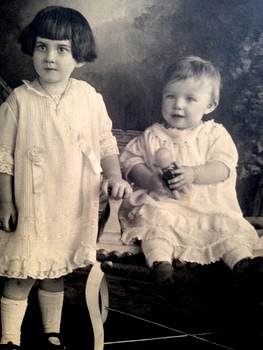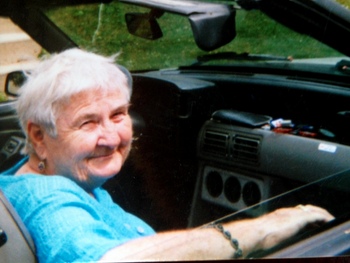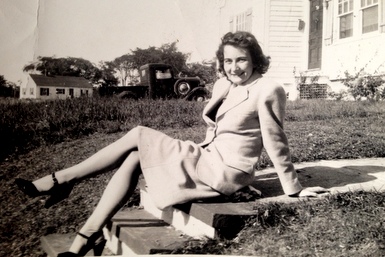Hospice: An End-of-Life Journey
“She is very, very independent.”
Mary Coyne has always been someone who has known her own mind.
“She’s ‘Charles in charge,’” her daughter, Maureen Mehlhorn says. “She’s a fighter. She’s always been a fighter.”
The daughter of Irish immigrants, Mary inherited a strong will and work ethic. At a time when postsecondary education wasn’t common for women, Mary attended business school.
“I generally went for typing jobs, but I wasn’t that great a typist, so I always ended up working on figures,” she says.
Mary’s jobs included working at Fort Preble, in the accounting department at A & P, and for what is now Anthem Blue Cross Blue Shield. Health insurance policies, she recalls, were much cheaper then.
“What it cost for a single subscriber was 85 cents a month,” she says.
Even after leaving the workforce to raise four children, Mary would get a job when there was something she wanted to buy.

Born in 1922, Mary grew up in Portland, attending Saint Dominic School. When she was age 12, her family moved to South Portland where her father had built a house. It would be where she would live most of her 93 years. Although she married and started her own family, she returned to care for her ailing mother and remained there after her mother died.
“It was a very happy neighborhood. It really was. The children could go out if they wanted. You didn’t worry about them. You opened the door and the kids went flying out, and the dogs went with them,” Mary recalls.
Mary enjoyed riding her bicycle to yard sales or taking daily walks to the grocery store or bank.
“She knows everybody in South Portland, everybody. She’s a fixture,” says Maureen.
It is little wonder then that when Mary learned in December that she was suffering from lung cancer, she knew, without hesitation how she wanted to spend her remaining days. She didn’t want aggressive treatment, and she wanted to remain at home.
Mary and her family connected with VNA Home Health Hospice, which is affiliated with Mercy Hospital and is part of Eastern Maine Health System. VNA Home Health Hospice works in partnership with patients and their families to provide end-of-life care and support.
“Hospice is really a philosophy of care about caring for individuals and families when their physician has determined they have a less than six-month-prognosis,” says Christine Turner, director of Hospice and Palliative Care. “That philosophy of care focuses on the physical, emotional, and spiritual needs of the patient.”
“When someone elects their hospice benefit, they’ve come to a point in their illness that they are very clear that they are not having benefit from aggressive intervention,” says Robin Hirsch-Wright, palliative care coordinator. “The goal is never to hasten death, but the goal is to journey. Hospice’s goal is to journey with the patient.”
Hospice care offered through VNA Home Health Hospice takes place in the home, as long as a patient’s condition can be managed there. The family remains the center of care but receives support from an interdisciplinary team that includes nurses, social workers, chaplains, home health aides, volunteers, bereavement counselors, the patient’s own attending physician, and the hospice director.
.JPG)
“Hospice nurses are trained in a different way. They specialize in end-of-life symptom management, end-of-life cases. We want patients to die with comfort and dignity,” says Dr. Lalaine Llanto, medical director. “We don’t want anyone to suffer.”
Each member of the team has a role to play. Nurses assess the patients’ needs in terms of symptom management; home health aides assist with personal care including bathing; chaplains provide spiritual support; and social workers help patients and families sort through details and make sure needs are being met.
“The hospice team can help families find joy in what is extreme sadness,” says Christine. “It can be a really beautiful time.”
The frequency of visits depends on the needs of the patient. In Mary’s case, a nurse stopped in twice a week.
“She just kind of checks with her, if my mother has any questions. She is very open with her, very open, and that’s what my mother wants,” says Maureen.
A social worker also visited, as have home health aides, and a volunteer.
“We had a volunteer come who was going to sit with her for a couple, three hours, and I felt funny leaving her. But then, I was immediately comfortable with the girl who came, and we hit it off, and it was very, very nice,” says Maureen.

“The family has been there all day, is exhausted. They’ve gone home, and our volunteer will go and sit for a while in the evening,” says Christine.
Some volunteers also bring Communion, and there is a prayer shawl ministry run by volunteers.
Hospice care is covered by Medicare, as well as many other insurance policies. In addition to the team of caregivers, the benefit covers medication related to the terminal illness, as well as medical equipment and supplies that are needed, for instance special beds or wheelchairs.
Maureen says cost was a concern for her mother who wanted to be sure she was able to leave something for her children.
“That’s a big plus, especially for this generation. I was very, very surprised about that. You know, they say, ‘You need this; you need that.’ And they kept saying, ‘We’ll pay for it.’ And I said, ‘Wait a minute. Who is we?’” says Maureen. “I don’t think people realize it’s covered by insurance.”
Despite the benefits of hospice care, many people don’t take advantage of it or wait until they are in the final days of their lives to do so.
There is fear that being referred to hospice means I’m dying right now. One of the things that we, as an industry, struggle with nationally is that the amount of time people are in hospice is still relatively short because referrals are made so late. When the team of people has time to develop relationships and allow the patient and the family to let us know what their preferences are, to know what their goals of care are, and for them to get to know us and trust us, that’s when we do our best work.”
Christine says it is not uncommon for patients to express regret they didn’t enter hospice sooner. And some studies have shown hospice care can prolong life.
“What happens is that less is more,” says Dr. Llanto. “The focus is more towards comfort so, sometimes, they’re not facing the side effects of the chemotherapy or those aggressive medications, so they come to live better, and sometimes live longer than expected.”
Dr. Llanto emphasizes that being in hospice care doesn’t mean giving up.
“It doesn’t mean that once you’re on hospice, you’re not going to be able to get off hospice. Because, once you’re not declining and you stabilize, you’re not eligible anymore,” says Dr. Llanto. “You can come off any time and come back at any time, as long as you meet the requirements.”
While hospice care depends on having a family caregiver present, that can take many forms.
“Sometimes, it’s the neighbor. Sometimes, it’s the kids. Sometimes, it’s a combination of people from church,” says Christine. “Many ex-spouses come back to be primary caregivers when their former husbands and wives are dying. It happens frequently.”
Those who don’t have nearby family members may be able to get assistance through VNA’s LifeStages.
 “Our LifeStages division is a private pay, non-medical companion service to provide those supports for patients who might not have an intact caregiving system. Or, our social workers will work with the patient’s family to try to help figure that out,” says Christine.
“Our LifeStages division is a private pay, non-medical companion service to provide those supports for patients who might not have an intact caregiving system. Or, our social workers will work with the patient’s family to try to help figure that out,” says Christine.
Hospice care is a subset of palliative care. As with hospice care, palliative care looks the physical, emotional, and spiritual needs of the patient, but those receiving palliative care do not need to be at the end stages of an illness.
“Palliative care is appropriate for anyone who has been diagnosed with a chronic and progressive illness that is life limiting,” says Robin. “In palliative care, you could be talking with a palliative care provider but also continuing with aggressive treatments.”
As with hospice care, Robin says the sooner patients look into it, the better.
“I’ve had providers sometimes say, ‘I would like you to see them, but it’s too early for a palliative care conversation.’ And, I always say, ‘Is it? Is it too early for a thoughtful conversation about what it’s like to navigate these sort of unsteady waters?’”
Robin says most palliative care connections are made in inpatient settings, but she wants to reach out to more primary care providers.
“There will always be a role for palliative care in an inpatient setting, but it should be part of that continuum of palliative care, part of the continuum of care in general,” she says.
Those working in palliative and hospice care say they are able to provide patients with something many providers cannot – time. They say a patient should never just be known as his or her diagnosis.
“Nowadays, with the kind of medical care where you need to see 20 patients in a day, you don’t have time to even ask, “What is the name of your cat at home? What is the name of your dog? What did you do for fun before you got sick?’ We do that. We spend time just talking with them,” says Dr. Llanto.
“It’s an interesting analogy to me that palliative care works so well because it is about making these kind of connections, and really, that just sort of mirrors why people want to be on this planet longer. They want to make those human connections,” says Robin.
“When someone gets a serious diagnosis, often, people run. I like to be that person, and I take pride in it honestly, who walks toward that situation. Where I found, in my time in this work, that I learn the most is when I sit and say the least and just listen to someone tell me their story,” she says.
“Most of the people who do this work feel called. It’s not a job. It really isn’t. It really is a calling,” says Christine. “The one regret that I have about doing this work is not having had the opportunity to know these people when they were in the prime of their lives. We’ve taken care of ballerinas, and opera singers, and WWII veterans, and Wall Street bankers, and farmers from Maine. And they all have a fascinating and interesting story.”
And, in some cases, another chapter in those stories is written while the patients are in hospice care. One woman always wanted to go up in cherry picker. A man wanted to visit Branson, Missouri.
“The Medicare benefit allows us to contract with other hospices if our patients are traveling out of state, so we contracted with a hospice in Branson, Missouri,” says Christine. “He got there. He went to a show, had a great time.”
“This hospice benefit provides people the time to do the things they want to do, so these wishes that you have in life,” says Lisa Fuller, vice president of Business Development and LifeStages.
Mary’s wish was to remain at home where her children and grandchildren could drop by, and, perhaps, surprise her with raspberry-filled cookies from the Cookie Jar Pastry Shop. It was a wish that was fulfilled. Mary died less than a week after her interview with Harvest in the place where she felt most comfortable, surrounded by those whom she most loved.











